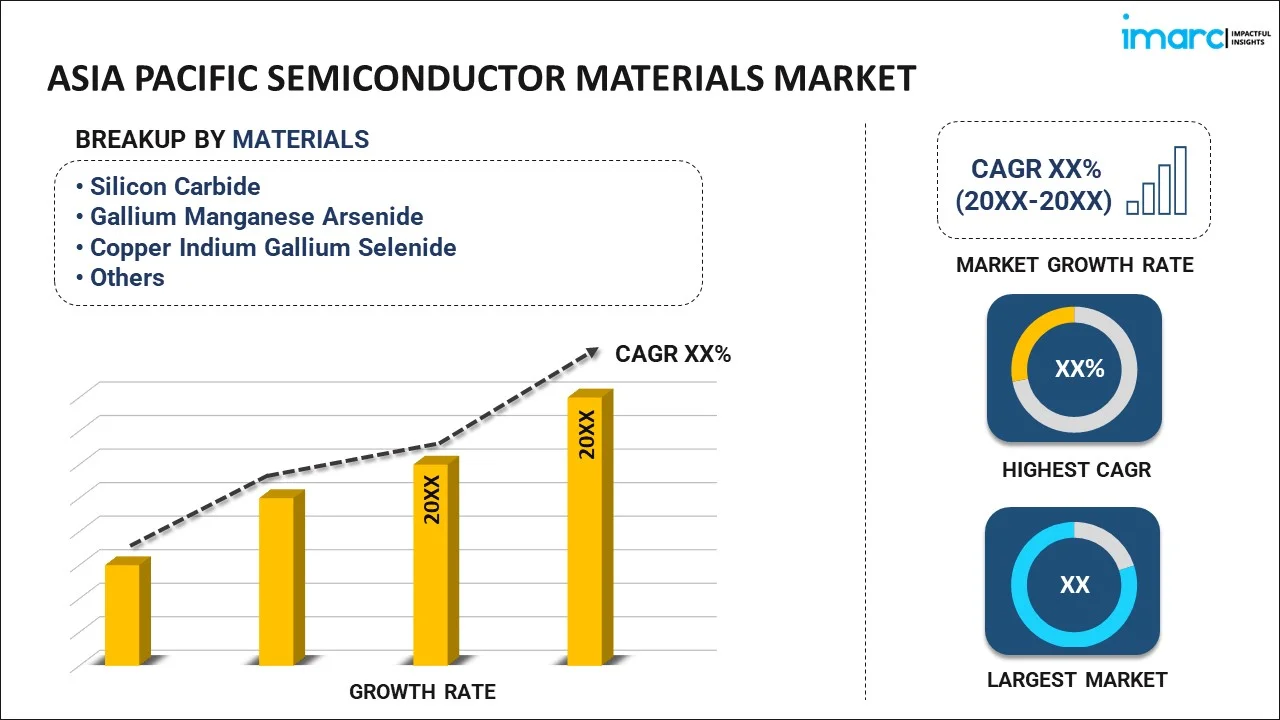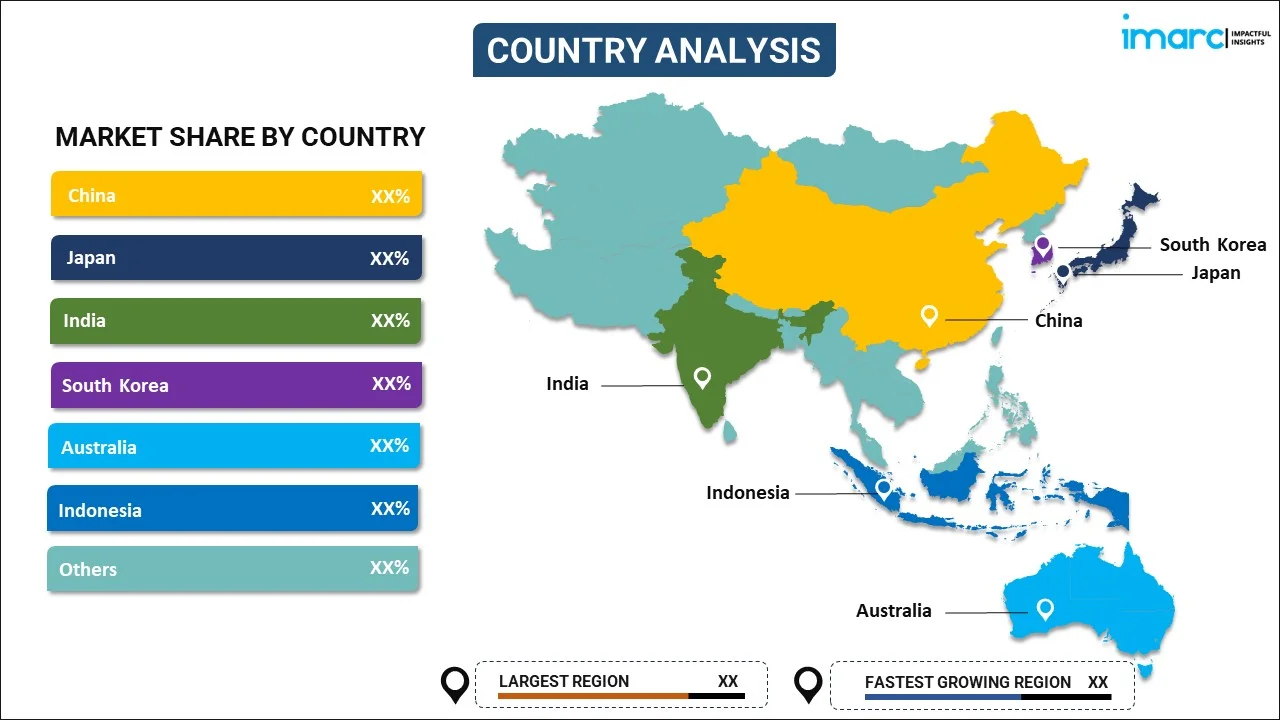
Asia Pacific Semiconductor Materials Market Report by Material (Silicon Carbide, Gallium Manganese Arsenide, Copper Indium Gallium Selenide, Molybdenum Disulfide, Bismuth Telluride), Application (Fabrication, Packaging), End Use Industry (Consumer Electronics, Manufacturing, Automotive, Energy and Utility, and Others), and Country 2025-2033
Market Overview:
The Asia Pacific semiconductor materials market size reached USD 41.7 Billion in 2024. Looking forward, IMARC Group expects the market to reach USD 57.8 Billion by 2033, exhibiting a growth rate (CAGR) of 3.7% during 2025-2033.
|
Report Attribute
|
Key Statistics
|
|---|---|
|
Base Year
|
2024
|
|
Forecast Years
|
2025-2033
|
|
Historical Years
|
2019-2024
|
| Market Size in 2024 | USD 41.7 Billion |
| Market Forecast in 2033 | USD 57.8 Billion |
| Market Growth Rate (2025-2033) | 3.7% |
Semiconductor materials have a conductivity bandwidth between conductors and insulators. These materials can conduct electricity only when they are exposed to light, heat or voltage posts. They exhibit variable resistance and pass current in one direction. As a result, they find extensive application in the production of transistors, lasers and solar cells.
Technological advancements in electronic products, along with the escalating demand for semiconductor packaging materials, represents one of the primary factors driving the market. Additionally, the increasing demand for premium smartphones on account of the inflating disposable incomes is driving the sales of semiconductor materials further. Besides this, the growing health consciousness among individuals has boosted the sales of smart bands, which is also fueling the market growth. However, the recent outbreak of the coronavirus disease (COVID-19) and the implementation of complete lockdowns by governing authorities in several countries have hampered the supply chains and the production in the manufacturing units of leading key players. The market is anticipated to recover losses once lockdown relaxations are introduced.
Key Market Segmentation:
IMARC Group provides an analysis of the key trends in each segment of the Asia Pacific semiconductor materials market report, along with forecasts at the regional and country levels from 2025-2033. Our report has categorized the market based on material, application and end use industry.
Breakup by Material:

- Silicon Carbide
- Gallium Manganese Arsenide
- Copper Indium Gallium Selenide
- Molybdenum Disulfide
- Bismuth Telluride
Breakup by Application:
- Fabrication
- Silicon Wafers
- Electronic gases
- Photomasks
- Photoresist ancillaries
- CMP Materials
- Photoresists
- Wet chemicals
- Others
- Packaging
- Leadframes
- Organic Substrates
- Ceramic Packages
- Encapsulation Resins
- Bonding Wires
- Die-Attach Materials
- Others
Breakup by End Use Industry:
- Consumer Electronics
- Manufacturing
- Automotive
- Energy and Utility
- Others
Breakup by Country:

- China
- Japan
- India
- South Korea
- Australia
- Indonesia
- Others
Competitive Landscape:
The competitive landscape of the industry has also been examined along with the profiles of the key players.
Report Coverage:
| Report Features | Details |
|---|---|
| Base Year of the Analysis | 2024 |
| Historical Period | 2019-2024 |
| Forecast Period | 2025-2033 |
| Units | Billion USD |
| Segment Coverage | Material, Application, End Use Industry, Country |
| Countries Covered | China, Japan, India, South Korea, Australia, Indonesia, Others |
| Customization Scope | 10% Free Customization |
| Post-Sale Analyst Support | 10-12 Weeks |
| Delivery Format | PDF and Excel through Email (We can also provide the editable version of the report in PPT/Word format on special request) |
Key Questions Answered in This Report:
- How has the Asia Pacific semiconductor materials market performed so far and how will it perform in the coming years?
- What has been the impact of COVID-19 on the Asia Pacific semiconductor materials market?
- What are the key regional markets?
- What is the breakup of the market based on the material?
- What is the breakup of the market based on the application?
- What is the breakup of the market based on the end use industry?
- What are the various stages in the value chain of the industry?
- What are the key driving factors and challenges in the industry?
- What is the structure of the Asia Pacific semiconductor materials market and who are the key players?
- What is the degree of competition in the industry?
Need more help?
- Speak to our experienced analysts for insights on the current market scenarios.
- Include additional segments and countries to customize the report as per your requirement.
- Gain an unparalleled competitive advantage in your domain by understanding how to utilize the report and positively impacting your operations and revenue.
- For further assistance, please connect with our analysts.
 Inquire Before Buying
Inquire Before Buying
 Speak to an Analyst
Speak to an Analyst
 Request Brochure
Request Brochure
 Request Customization
Request Customization




.webp)




.webp)












